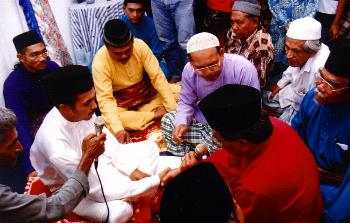Offer and acceptance of marriage (Akad Nikah)
Marriage for Muslims is based on Islamic law. Offer and acceptance of marriage, also known as akad nikah is the most important thing in Malay wedding. Without this, one’s marriage is not considered valid or ‘sah’ to Islamic point of view. In this offer and acceptance of marriage ceremony, ‘imam’ or ‘kadhi’ ,a religious official of the Syariat Court, who represents bride’s side will offer marriage to the groom. In olden days, it was customary for the bride’s biological father to perform this function. The exact dialogue is :
Kadhi: I marry thee to (so and so) with the mas kahwin of RM (depend on which state) (“Aku nikahkan engkau dengan (disebut nama pengantin perempuan) dengan mas kahwin (disebut jumlahnya) tunai/hutang”)
Groom then will accept the marriage.
Groom: I accept this marriage with (so and so) with the mas kahwin of RM _____ (“ Aku terima nikahnya dengan (disebut nama pengantin perempuan) dengan mas kahwin (disebut jumlahnya) tunai/hutang.)
A small sum of money called the mas kahwin seals the contract. This ‘akad nikah’ should be articulated clearly so that imam and two witnesses hear and are satisfied with it. If everybody agrees, then only the ‘akad nikah’ effectively forges the union. After this is being done, imam will read ‘khutbah nikah’ which contain the responsibilities for both the husband and the wife in a family.
In certain state, both groom and the bride has to sign marriage contract (surat perjanjian nikah). This ceremony is end with prayer and feast. In addition, this ‘akad nikah’ often take place at the bride’s place. The recent trend, though, is to hold the solemnization in the mosque as was performed during the Prophet Muhammad’s time.
Beautification Rite
Berandam or beautification rite is a ceremony to make the bride more beautiful or ‘menaikkan seri’. Beside that , beautification rite is to throw away the bad luck or ‘sial’ that may be reside on the bride in order to avoid something bad happen to the bride during the wedding day. Usually this ceremony been carried out a few days before the wedding day.
The ceremony is carried out by a woman that is expert in this ceremony. The woman is known as ‘Mak Andam’. She also experts in ‘jampi serapah’. During the ceremony the bride will have her forehead’s hair shaved, manicure and pedicure, facial hair been shaved together with some specific body parts, shaved the eye brow , and the teeth are sharpened with some special sharpener. After that, the bride will have her hair washed and showered with water that has been add with some lime juice ‘ perahan limau purut’.
The bride will ‘ dilangir’ or smear with ‘bedak sejuk’. To make the bride more beautiful the Mak Andam will say some prayer, ‘selawat’ and ‘jampi serapah’.
There are some superstitious that the bride must follow after the ceremony, for example cannot see the mirror or walk on the ground for a few day until the wedding day. By doing that, it is believed that the bride is prevented from something bad because the bad luck that she own has been thrown away.
Nowadays, beautification rite is still available but there are some minor changes. Mak Andam prefer to make up the bride with modern make up. However, some of the traditional ritual stated above is still preserved.
Berinai ( henna application)
One of the ceremony in Malay wedding that is still being practice on this days is “berinai” or henna application. There are two types of “berinai”, small hennaed (berinai kecil) and large hennaed (berinai besar).
“Berinai kecil” means the bride’s palms and feet are ‘decorated’ with the dye from the henna leaves. The next day, the bride’s palms and feet will stay red and last for months. “berinai kecil” is held two or three days before or on the wedding day.
“Berinai besar” means hennaed ceremony that held when the bridal is sitting in state on their wedding day. The relatives and guests will put the dye on the bride and groom’s palms.
Sometimes this is followed by the “tukar pakaian” (costume changes) and the bride and, less often, the groom will don different clothes for photography. The “pelamin” (raised dais) will be beautifully decorated for the purpose.
designed
& maintained by : Afza
